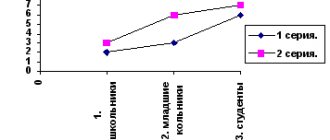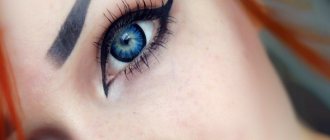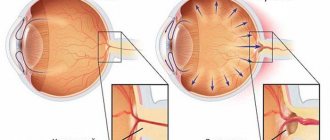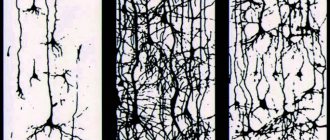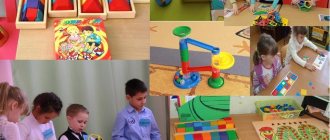As in the first type, they need to set themselves a special task in order to understand the essence of a phenomenon or adequately perceive any object. The stories of such people, as a rule, are filled with large details, behind which the meaning of the whole is often lost.
These two types of perception are characteristic of extreme poles; most often they complement each other. Their extreme variants cannot be considered as negative, because they determine the uniqueness of perception that gives a person the opportunity to be an extraordinary person.
Other types of perception
Other types of perception include, for example:
- Descriptive and explanatory. Persons of the descriptive type limit themselves to the factual side of what they see and hear and do not try to explain to themselves the essence of the perceived phenomenon. The driving forces behind people's actions remain outside their attention. People of the explanatory type, on the contrary, are not satisfied with what is given in perception. They need to explain what they saw and heard. Most often, this type of behavior is combined with a holistic or synthetic type of perception;
- Objective and subjective type of perception. For the objective type, strict compliance with what is happening in reality is important. Representatives of the subjective type bring a lot of themselves and go beyond what is actually given. Most often, they convey not what they perceived, but their subjective impressions.
Among individual differences in perception, differences in observation play an important role.
Individual characteristics of perception
Peculiarities of perception depend not only on life experience, personality orientation, interests, richness of the spiritual world, etc., but also on individual characteristics. What are these features?
People differ, firstly, in the nature of receiving information. Scientists identify a holistic (synthetic) type of volition, when they do not attach importance to details and do not like to go into them. This type is characterized by a focus on the essence, meaning, generalization, and not on details and particulars. The detailing (analytical) type of perception, on the contrary, is focused on details.
It is quite obvious that the most productive is a combination of both methods.
Secondly, by the nature of the reflection of the information received. Here we distinguish between descriptive
and
explanatory types
of perception.
The descriptive type
is focused on the factual side of information: a person reflects and gives out what he sees and hears, what he reads, getting as close as possible to the original data, often without delving into their meaning. This type of perception is very common among schoolchildren, hence the frequent requests from the teacher: “Tell me in your own words.”
Explanatory type
is not satisfied with what is immediately given in perception itself. He tries to find the general meaning of the information. The best thing is the golden mean. But this is not always achieved. To create harmony of these types of perception, it is necessary to know their characteristics, have an idea of their mechanisms, be able to diagnose them, and carry out pedagogical work on this basis.
Thirdly, by the nature of the personality itself. Here we distinguish the objective type
perception, when a person is focused on the accuracy of perception, impartiality.
We can say that he has developed an immunity to guesses, assumptions, conjectures, etc., and a subjective type, when
This is the most common everyday type of perception. Remember the story of A.P. Chekhov's "Chameleon".
2.5. Observation and observation
Observation is perception, closely related to the activity of thinking - comparison, discrimination, analysis. Observation is the purposeful, planned perception of objects and phenomena in which we are interested. To observe means not just to look, but to consider, not just to listen, but to listen, to listen, not just to smell, but to sniff. This is very accurately reflected in folk proverbs and sayings:
And he looks, but doesn’t see.
Sighted, but not sharp-sighted.
My ears are plugged for this.
Observation is always carried out with a specific cognitive purpose. It presupposes a clear understanding of the objectives of the observation and the preliminary development of a plan for its implementation. It is impossible to observe if you do not know what exactly needs to be observed and for what purpose. Clarity of the purpose and objectives of observation activates an important characteristic of perception - selectivity.
A person does not perceive everything that catches his eye, but identifies the most important and interesting for himself. Perception, attention, thinking and speech are combined during observation into a single process of mental activity. Therefore, observation presupposes greater activity of the individual and helps to better understand reality.
Observation is a personality trait, the ability to observe and notice characteristic, but little noticeable features of objects, phenomena, and people. It is closely related to the development of a person’s professional interests, as it is improved in the process of systematically engaging in the chosen occupation.
The ability to observe plays a huge role in a wide variety of areas of human activity.
Observation is well developed among artists, writers, and poets.
...Ivan-da-Marya, St. John's wort, Chamomile, Ivan-tea, tartar, Shrouded in divination, Gawking, encircling the bushes...
B. Pasternak.
“Silence” Observation is necessary for the teacher. Without careful, constant observations, it is impossible to deeply understand the psychological characteristics of a child and outline the correct paths for his development and upbringing.
The teacher's highly developed observational skills contribute to the development of his pedagogical tact. Working with children, an observant teacher captures the children’s subtle moods, deviations from their usual state and builds his relationship with them in accordance with these states.
Observation as a personal professional quality develops in a teacher gradually, in the process of gaining experience in teaching and becoming familiar with psychological knowledge.
Various recommendations and schemes have been developed for conducting observations of the characteristics of the mental development of students, intended for teachers. Let's take one of these schemes as an example.
1. The nature of the teacher’s attraction of students’ attention at different stages of the lesson, depending on the age of the students. The speed of establishing attention at the beginning of the lesson. Peculiarities of attention during questioning, when perceiving new material, when repeating, when checking homework.
2. Focus and stability of students’ attention to the teacher at various stages of the lesson. Causes of distraction. The means by which the teacher achieves concentration and sustained attention of students.
3. Features of switching students’ attention to the teacher within the framework of a homogeneous activity and during the transition from one stage of the lesson to another. Switching speed (transition interval duration), switching errors. Ways to organize switching attention during the lesson.
4. Distribution of attention of students and teachers during the lesson (how it was expressed and how it was organized by the teacher).
5. The teacher takes into account the age-related characteristics of students’ attention span in various learning situations (the number of task elements presented for perception, conditions, designations, etc.).
6. Dynamics of types of students’ attention at various stages of the lesson (involuntary, voluntary, post-voluntary).7. Features of attention manifestations depending on its external or internal orientation when reading a book, looking at a book or map, a teacher’s story, as well as during recall of a formula, poem, reflection and in other situations.
8. Means (methods, techniques) by which students regulated their attention, organizing it in accordance with the requirements and tasks of the teacher in a specific learning situation.
9. The presence or absence of a synchronous form of collective attention. The reasons that determine this form of attention (for example, a high degree of cohesion in the mental, emotional or active concentration of students).
10. Reasons for the lack of synchrony of attention (discrepancy between individual and given pace, lack of unity of assessment, understanding, assimilation; inability to correlate the main and secondary, etc.).
11. The dependence of students’ attention in the lesson on the content of the material - its imagery, accessibility, emotionality, as well as on the teacher’s ability to activate the entire cognitive sphere of the student’s personality, on the teacher’s control, on the students’ attitude to the teacher and to the lesson, on the teacher’s ability to psychologically competently use demonstration material1.
When working with a map, it is essential to capture what is being observed as completely as possible. The main difficulties of observation are to highlight the main thing from what you see. At the same time, it is important not to replace the actually observed fact with your own interpretation.
At the same time, a teacher, like any specialist, who by the nature of his work communicates a lot with people, accumulates many observations without a special plan, spontaneously. This rich experience of observing a child in different situations creates the basis for what is called “pedagogical intuition” and allows, almost without thinking, to choose the only correct words that this particular student needs. However, this experience often remains unthought and unthought. It is very difficult to transfer it to another teacher, sometimes even difficult
1 See: Baskakova I.L.
Attention of a preschooler, methods of its study and development. Studying the attention of schoolchildren. - M.; Voronezh, 1995. -S. 40-41.explain to yourself. To systematize and understand such spontaneous observations, special schemes are being developed. One of these diagrams intended to be filled out by the teacher is the “Observation Map” by D. Stott. It is aimed at identifying various types of behavioral disorders. This map consists of a description of different behaviors that the teacher can observe in children. The teacher is asked to assess whether or not the child exhibits a particular form of behavior. The concentration of symptoms in any one area allows us to understand the causes of the child’s emotional difficulties, behavioral disorders, etc.
Let's take one of the parts of this map as an example.
“Anxiety towards adults. Anxiety and uncertainty about whether adults are interested in him, whether they love him...
1. Performs his duties very willingly.
2. Shows an excessive desire to greet the teacher.
3. Too talkative (bothers with his chatter).
4. Very willingly brings flowers and other gifts to the teacher.
5. Very often brings and shows the teacher objects, drawings, models, etc. he has found.
6. Being overly friendly towards the teacher.
7. Tells the teacher an exaggerated amount about his family activities.
8. “Sucks up”, tries to please the teacher
9. Always finds an excuse to keep the teacher busy with his special someone.
10. Constantly needs help and control from the teacher”1.
Observation
Observation is understood as the ability to notice in objects and phenomena that which is little noticeable in them and does not catch the eye by itself. A sign of observation is the speed of perception of something subtle. This skill is not typical for all people and to varying degrees.
Differences in observation mainly depend on individual abilities. It is she who is the factor that contributes to its development.
There are differences in perception based on the degree of intentionality:
- Intentional - voluntary perception. From the very beginning, it is regulated by the task - to perceive this or that object, to become familiar with it. It can be included in some activity and carried out during its implementation, but it can also act as an independent activity;
- Unintentional or involuntary perception. With this perception, a person is not guided by a predetermined goal of perceiving a given object. Perception is directed by external circumstances.
Like perception, observation is not an innate characteristic. A newborn child cannot perceive the world around him as a whole objective picture. This ability appears much later.


